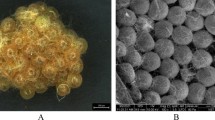Abstract
This study investigated development, reproduction and life table parameters of the astigmatid mold mite Tyrophagus putrescentiae (Schrank) (Acari: Acaridae) feeding on egg-masses or adult females of the nematode Meloidogyne incognita, egg-masses of the nematode Rotylenchulus reniformis, ras cheese or yeast at 25 ± 1 °C, 70 ± 10 % RH in the dark. Immature developmental times were shorter when the mite was fed females of M. incognita followed by yeast. Different prey/diet types had no significant effect on longevity and lifespan of both males and females. Daily oviposition rate (eggs/female/day) was highest for mites fed yeast (20.8 ± 1.8 eggs) and lowest for mites fed females of M. incognita (6.6 ± 0.5). Intrinsic rate of natural increase (r m) was highest for mites fed yeast compared to other prey/diet; no significant differences in r m were observed among mites fed on non-yeast diets. This result may suggest a role of T. putrescentiae as biocontrol agent of plant-parasitic nematodes and the yeast may be used for mite mass-production purposes.
Similar content being viewed by others
References
Abou El-Atta DA, Ghazy NA, Osman MA (2014) Effects of temperature on the life-history traits of Sancassania (Caloglyphus) berlesei (Acari: Astigmatina: Acaridae) feeding on root-knot nematodes, Meloidogyne spp. (Nematoda: Meloidogynidae). Exp Appl Acarol 64:299–307
Al-Shammery KA (2014) Influence of feeding on three stored product pests on rearing of the predatory mite Cheyletus malaccensis (Acari: Cheyletidae) in Hail, Saudi Arabia. Life Sci J 11:260–266
Bilgrami AL (1994) Predatory behaviour of a nematode feeding mite Tyrophagus putrescentiae (Sarcoptiformes: Acaridae). Fundam Appl Nematol 17:293–297
Bilgrami AL, Tahseen Q (1992) A nematode feeding mite, Tyrophagus putrescentiae (Sarcoptiformis: Acaridae). Fundam Appl Nematol 15:477–478
Birch LC (1948) The intrinsic rate of natural increase of an insect population. J Anim Ecol 17:15–26
Brust GE, House GJ (1988) A study of Tyrophagus putrescentiae (Acari: Acaridae) as a facultative predator of southern corn rootworm eggs. Exp Appl Acarol 4:335–344
Duek L, Kaufman G, Palevsky E, Berdicevsky I (2001) Mites in fungal cultures. Mycoses 44:390–394
Ekmen ZI, Hazir S, Cakmak I, Ozer N, Karagoz M, Kaya HK (2010) Potential negative effects on biological control by Sancassania polyphyllae (Acari: Acaridae) on an entomopathogenic nematode species. Biol Control 54:166–171
Hill DS (2002) Pests of stored foodstuffs and their control. Kluwer, New York
Hubert J, Jarošík V, Mourek J, Kubatova A, Zdarkova E (2004) Astigmatid mite growth and fungi preference (Acari: Acaridida): comparisons in laboratory experiments. Pedobiologia 48:205–214
Hussey RS, Barker KR (1973) Comparison of methods of collecting inocula of Meloidogyne spp., including a new technique. Plant Dis Rep 57:1025–1028
Karagoz M, Gulcu B, Cakmak I, Kaya HK, Hazir S (2007) Predation of entomopathogenic nematodes by Sancassania sp. (Acari: Acaridae). Exp Appl Acarol 43:85–95
Kheradmand K, Zamani AA (2008) Life table and reproductive parameters of two mushroom pests, Tyrophagus putrescentiae (Acari: Astigmata) and Pediculaster flechtmanni (Acari: Prostigmata). J Entomol Res 32:99–102
Kheradmand K, Kamali K, Fathipour Y, Goltapeh EM (2007) Development, life table and thermal requirement of Tyrophagus putrescentiae (Astigmata: Acaridae) on mushrooms. J Stored Prod Res 43:276–281
Lawo JP, Lawo NC (2011) Misconceptions about the comparison of intrinsic rates of natural increase. J Appl Entomol 135:715–725
Meyer J, Ingersoll C, McDonald L, Boyce M (1986) Estimating uncertainty in population growth rates: jackknife vs. bootstrap techniques. Ecology 67:1156–1166
Muraoka M, Ishibashi N (1976) Nematode-feeding mites and their feeding behaviour. Appl Entomol Zool 11:1–7
Pakyari H, Maghsoudlo M (2011) Development and life table of Tyrophagus putrescentiae (Astigmata: Acaridae) on mushroom and phytonematode. Acad J Entomol 4:59–63
Palyvos NE, Emmanouel NG (2011) Reproduction, survival, and life table parameters of the predatory mite Cheyletus malaccensis (Acari: Cheyletidae) at various constant temperatures. Exp Appl Acarol 54:139–150
Papadopoulou SC (2006) Tyrophagus putrescentiae (Schrank) (Astigmata: Acaridae) as a new predator of Lasioderma serricorne (F.) (Coleoptera: Anobiidae) in tobacco stores in Greece. J Stored Prod Res 42:391–394
Rasmy AH, Elbagoury ME, Reda AS (1987) A new diet for reproduction of two predaceous mites Amblyseius gossipi and Agistemus exsertus [Acari: Phytoseiidae, stigmaeidae]. Entomophaga 32:277–280
Sánchez-Ramos I, Castañera P (2001) Development and survival of Tyrophagus putrescentiae (Acari: Acaridae) at constant temperatures. Environ Entomol 30:1082–1089
Sánchez-Ramos I, Castañera P (2005) Effect of temperature on reproductive parametersand longevity of Tyrophagus putrescentiae (Acari:Acaridae). Exp Appl Acarol 36:93–105
Stirling GR, Kerry BR (1983) Antagonists of the cereal cyst nematode Heterodera avenae Woll. in Australian soils. Aust J Exp Agr 23:318–324
Ulug D, Hazir S, Kaya HK, Lewis E (2014) Natural enemies of natural enemies: the potential top-down impact of predators on entomopathogenic nematode populations. Ecol Entomol 39:462–469
Walia KK, Mathur S (1995) Predatory behaviour of two nematophagous mites, Tyrophagus putrescentiae and Hypoaspis calcuttaensis on root-knot nematode, Meloidogyne javanica. Nematol Mediterr 23:255–262
Walter DE, Hudgens RA, Freckman DW (1986) Consumption of nematodes by fungivorous mites Tyrophagus spp. (Acarina: Astigmata: Acaridae). Oecologia 70:357–361
Acknowledgments
We thank Dr. S.A. Eraky of the Plant Protection Department, Faculty of Agriculture, Assiut University, Egypt, for identifying the mite species and Dr. A.M. Mostafa Fatma of Agricultural Zoology Department, Faculty of Agriculture, Mansoura University, Egypt, for identifying the nematodes species. Also, we thank Dr. N.A. Ghazy of Agricultural Zoology Department, Faculty of Agriculture, Mansoura University, Egypt, for reviewing an early draft of this manuscript.
Author information
Authors and Affiliations
Corresponding author
Rights and permissions
About this article
Cite this article
Abou El-Atta, D.A.EM., Osman, M.A. Development and reproductive potential of Tyrophagus putrescentiae (Acari: Acaridae) on plant-parasitic nematodes and artificial diets. Exp Appl Acarol 68, 477–483 (2016). https://doi.org/10.1007/s10493-015-0002-5
Received:
Accepted:
Published:
Issue Date:
DOI: https://doi.org/10.1007/s10493-015-0002-5




